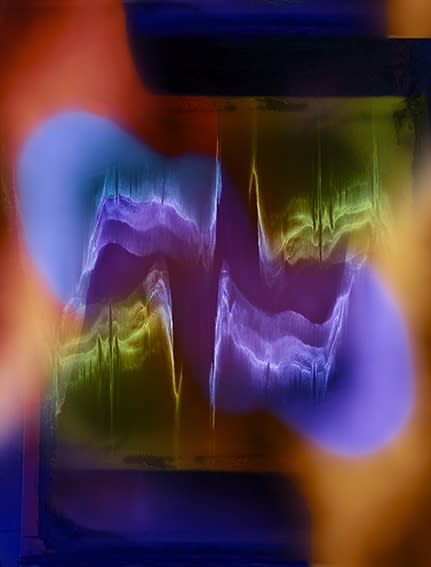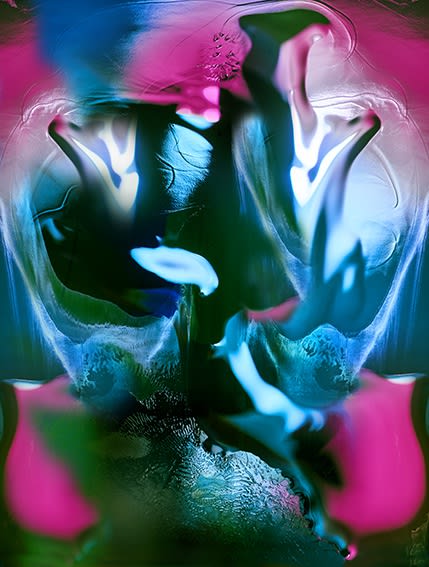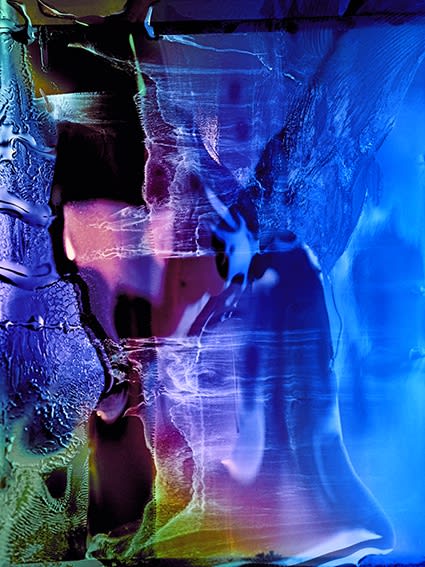-

-
With an ever growing demand for instant results, AI is threatening the humanity of art, with photography the most vulnerable medium. Mark Roper, however, is undeterred by the advancements of the digital world, instead embracing this new frontier through surprisingly traditional techniques. Nostalgia poetically fuses modern methods and traditional materials to create dynamic impressions of the future from images of the past, transporting the viewer to a world that is both contemporary and nostalgic.Several years ago, the artist began manipulating old and discarded polaroids by experimenting with chemicals traditionally used in the polarisation process. Roper discovered a fascinating occurrence when the chemicals reacted with the exisiting polaroid. The result was a magical symphony of colour and light. Fluid forms swam across the composition, dripping off the paper and onto the viewer. Once satisfied with the composition, Roper documents the final result with a digital camera. In many ways Roper’s process embodies a history of photography, as he begins his process with traditional film photography and ends it with digital machines, ultimately creating compositions that are boldly futuristic and experimental.
-
Over time, Roper has developed and finessed his process. In many ways, his method of working bares a similarity to the process of painting, as he continually layers chemicals to produce his desired composition. “I wanted to slow things down,” explains the artist. Partly inspired by the boom in AI technology and the threat it poses towards man-made art, Roper was inspired to invest more time and patience into his practice. He began to gradually manipulate his images, allowing the chemicals to develop and slowly evolve slowly. By using traditional methods of photography and manual augmentation, Roper creates something uniquely human. The use of chemicals creates an interesting balance between intention and circumstance; although Roper controls how and where he applies the chemicals, he cannot always predict the result. As such, Roper produces outcomes that are organic and irreplaceable by artificial intelligence.
-
Roper’s murky and futuristic compositions evoke sentiments of the past. Abstract memories seem to float in primordial streams of colour and light as old polaroids dissipate into a pool of chemicals. Here, Roper melts away the past to create a nostalgic vision of the future. Nostalgia acknowledges the role of the past, whether this be traditional methods of photography or forgotten polaroid images, in creating our vision of the future.
-
-
Each work is available in three sizes. Bespoke Acrylic Box Frames are available in a wide selection of colours. These frames are not essential to hang the work but add to the overall aesthetic.40 x 50 cm, Limited Edition 8, $225010 x payments of $225 via Art Money+ Acrylic Box Frame $55070 x 92 cm, Limited Edition 5, $400010 x payments of $400 via Art Money+ Acrylic Box Frame $650112 x 150 cm, Limited Edition 3, $660010 x payments of $660 via Art Money+ Acrylic Box Frame $1300
-
In Conversation with Mark Roper
OTOMYS: What are the ideas behind this new body of work?Mark Roper: This body of work is called Nostalgia. I wanted to create a body of work that employs traditional photography methods, elements and materials, such as Polaroid. I take these traditional methods and materials and combine them with modern advancements in photography, creating a hybridised practice that conflates the past with the future. This synthesis was partly inspired by the recent phenomenon of AI images and society’s insatiable desire for instant results. I believe that art cannot be rushed. It requires thought and patience. Within this body of work I wanted to slow things down, using traditional techniques to create surrealistic worlds.OTOMYS: It is hard to believe that your works are a product of photography, as the fluid forms within your compositions look completely otherworldly. How do you achieve your images?Mark Roper: The base image is created on Polaroid film. This process can be quite unpredictable, producing a unique image each time. I examine each image carefully, identifying unique colours and shapes that have formed organically during this process. I then manipulate and exaggerate these features with chemicals that react to the surface of the film. In many ways, this process is like a primitive form of photoshop. As I begin to create new elements the film evolves constantly, with new shapes and colours slowly revealing themselves. I repeat this process many times, continually adding new layers and creating a strong sense of depth and visual complexity. Once I am satisfied with the composition, I digitally record the final image. I treat each Polaroid as a painting, slowly building up layers and developing the composition.OTOMYS: How has your background in commercial and editorial photography influenced your ventures as a contemporary artist?Mark Roper: I work in interior, portrait and food photography, all of which inspire my art practice. Working within these fields has allowed me to observe my surroundings with a different perspective, forcing me to look at details that are otherwise overlooked. As a photographer it is essential to create a visual language that is not only unique, distinct and recognisable, but true to your intentions as a creator. When creating my artwork I find myself frequently returning to the colours, mood and tone that I have captured in my commercial projects, reinterpreting these elements in abstract and experimental ways.OTOMYS: Your works often adopt a large format that immerses the viewer into the stunning visuals of your work. What is the importance of scale within your practice?
Mark Roper: I try to produce both bold and subtle layers throughout the work. I believe that a large scale image encourages the viewer to return to the artwork, with each visit uncovering new elements. There is a lot to explore within a large scale image. I also believe this scale allows the viewer to truly immerse themselves within the otherworldly atmosphere of my artworks, transporting them into a different dimension. The drama and impact of a large scale work is unparalleled, with the work ultimately becoming a part of the interior architecture.
Mark Roper: Nostalgia
Past viewing_room















